 Research Article
Research Article
Road Traffic Accidents, Near-Misses and their Associated Factors among Commercial Tricycle Drivers in a Nigerian City
Ahmed Dahiru Balami, Centre for Disaster Risk Management and Development Studies, University of Maiduguri, PMB 1069, Maiduguri, Nigeria.
Received Date: May 22, 2019; Published Date: May 28, 2019
Abstract
Background: Tricycles form an important part of the intra-city transport system, following the ban placed on motorcycles in Maiduguri, Nigeria. However, no previous studies have been conducted to assess the occurrence of accidents among them.
Objectives: The objective of this study was to determine the prevalence of road accidents, near-misses, and their associated factors among commercial tricycle drivers in Maiduguri.
Methods: A cross-sectional study was conducted among registered commercial tricycle drivers in Maiduguri who had been in the business for at least a year. Data was collected through face-to-face interviews, using a structured questionnaire, and was subjected to bivariate and multivariate analysis using SPSS.
Results: The prevalence of road accidents and near misses were 46% and 50.3% respectively. Only six (3.9%) of respondents who had experienced a near-miss mentioned that they occurred while they were fully awake; during clear weather; and on a smooth, broad, and noncongested road. All the others had experienced the near miss under an unfavourable weather, road, and/or while feeling sleepy. In the bivariate analysis, only psycho-active substance use (χ2=3.941; df=1; p=0.047) and having experienced more than one near miss (χ2=31.807; df=1; p<0.001) were significantly associated with having an accidents. However, in the multivariate analysis, having experienced more than one near miss was the only factor which significantly predicted having an accident (OR=2.89 95% CI: 1.64-5.09; p<0.001).
Conclusion: There is a need to conduct further intervention studies to determine the effectiveness of intervention measures in reducing accident rates among these tricycle drivers.
Keywords: Road accident; Near-miss; Tricycle; Vehicular factors; Driver factors
Introduction
The morbidity and mortality burden from road traffic accidents (RTAs) in developing countries has been on the increase [1]. In almost all countries in Africa, Asia and Latin America, road traffic crashes have become one of the leading causes of deaths in older children and economically active adults between the ages of 30 and 49 years [2]. They also cost these countries 1–2% of their gross national product (GNP) yearly, from premature death, disability, medical expenses, loss of productivity, and material damages [3]. The World Health Organization (WHO) and World Bank estimate that within the next two decades, the rate of fatal traffic crashes in high income countries would be reduced by as much as 28%; however, in low and middle income countries, the fatal crash rate will increase by nearly 92% to 147% [4,5]. In Nigeria, the main victims of RTAs are pedestrians, cyclists and public transport passengers [6]. Nigeria loses about 80 billion naira annually to road accidents, and of all persons involved in road traffic accidents in Nigeria, 29.1% suffer disability, while 13.5% are unable to return to work [7,2].
Road traffic accidents (RTA) are accidents which happen on the road between two or more objects, one of which must be any kind of moving vehicle [8]. There have been attempts to explain the occurrence of road accidents using theories. The systems theory is based on the concept of risks and man-environment adjustments and maladjustments [9]. The components of the theory are the environment, the means of transport and the behaviour of man [10]. Driver factors in road traffic accidents are all factors related to drivers and other road users which include their sociodemographic characteristics, physiological factors and behavioural factors [11]. In a study among motor drivers in the College of Medicine, Ibadan, vehicular mechanical faults had been reported in 50% of reported accidents [12]. Risk factors such as poor vehicle maintenance (including tyres, brakes, and lights) and driving old vehicles were also identified in Ethiopia and Libya [13,14]. Road conditions (construction, surface, wet or dry), obstacles (e.g. debris on the road) and the landscape near the road were reportedly major contributors to RTAs [15]. A study among commercial drivers in a city in South-southern Nigeria showed that the drivers perceived that the nature of the road; time of the day; and weather, were some of the major contributory factors to road accidents [16]. Chocked roads were also reportedly associated with higher risks of a road traffic crash in Libya [17].
Near-miss has been defined as sudden braking and rapid steering operations by the driver without resulting in an accident [18]. They have also been defined as a detected event that has not caused any harm, and therefore has limited immediate impact [19]. The use of a ‘scale of danger’ was suggested for determining nearmiss accidents and proposed for this ‘danger scale’ is the ‘timemeasured- to-collision’ (TMTC) between two vehicles involved in an unsafe event [20]. One second had been concluded as a good TMTC threshold for defining near-miss accidents. Near-misses had also been pointed out to constitute the major determinant of workplace level of safety, with several near-misses preceding the occurrence of an actual accident. In a similar light, near-misses on our roads could serve as a very good determinant of the level of road safety as they have been reported to be important predictors of actual driving accidents [21]. The odds of reporting at least one actual accident was about twice (OR=1.13; 95% CI: 1.10-1.16) among those reporting four or more near-miss sleepy accidents [19].
Motorcycles are a part of the essential mode of transportation in most developing countries and pose the greatest risk of serious injury or death compared to other means of transportation [22]. A similar state could be said of Maiduguri, until a total ban was placed on motorcycles in the year 2011, after which they gradually got replaced with tricycles. There is need to view RTAs as an issue of urgent national importance that needs urgent attention aimed at reducing the health, social, and economic impact [23]. However, relevant information needed for such policy making and for relevant interventions are lacking. To the best of our knowledge, no road traffic accident studies have been conducted among tricycle drivers in Nigeria. There have also been no studies on near miss driving accidents, and it is not even captured in the Annual Report of the Federal Road Safety Commission (FRSC).
The objective of this study was to determine the prevalence of accidents and near-misses and their associated factors among commercial tricycle drivers in Maiduguri, North-eastern Nigeria. With the prevailing paradigm shift of focus from disaster management to disaster risk reduction, an effort to investigate the occurrence of near-misses and actual driving accidents associated with a very important means of commercial transport (tricycles) on our roads seems logical. The results of this study would objectively reveal the level of road safety in Maiduguri, and the role played by certain factors in determining road safety. This would guide the development of evidence-based road traffic accident intervention programmes which would further improve the present observed trend.
Material and Methods
This study was conducted in Maiduguri, the Borno state capital, located in North-eastern Nigeria. Borno state is located between latitudes 10° 30’ and 13° 50’ north and longitudes 11.00° and 13° 45’ east, with a total land area of 69,435 km2 [24]. It has a population of 540,016 consisting of 282,409 males and 257,607 females [25]. It is a cosmopolitan town consisting of the indigenous ethnic group, the Kanuris and other ethnicities from the state and other states in northern Nigeria and even other parts of the country. An image of a tricycle is presented in Figure 1.
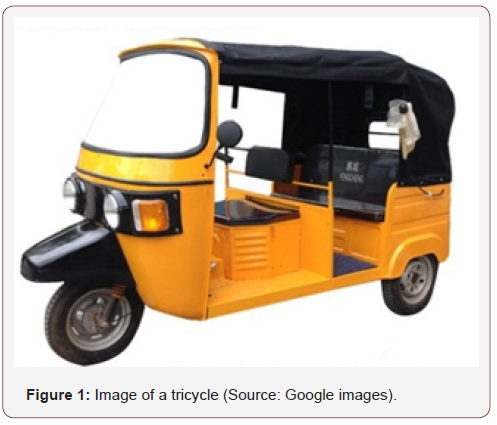
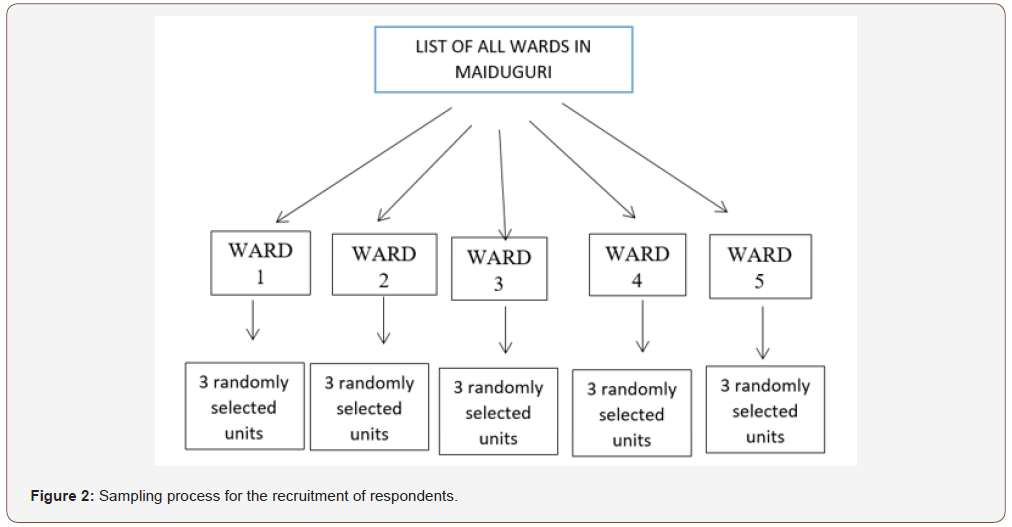
The dependent variables in this study were near-misses and driving accidents. The independent variables were: sociodemographic factors; vehicular factors and driver factors. Validated bi-lingual (English and Hausa languages) questionnaire was used for data collection. The items of the questionnaire were developed from extensive review of publications of the FRSC and other relevant research articles. It was first developed in English language and then translated into Hausa language by a senior University academic staff of the Hausa Language Department. The questionnaire consisted of six broad sections: socio-demography; physiological factors, driver behavioral factors, vehicular factors, diver factors and environmental factors.
Due to low literacy rates, questionnaires were administered as face-to-face interviews. A person with educational background up to Diploma level was engaged to serve as an enumerator. Two to three training sessions were held for the enumerator to ensure a good grasp of the contents of the questionnaire; and training on how to avoid interviewer bias. Content validity was assessed using an expert group [27] who went through the questionnaire to ensure that wordings of its items are clear and that they represented their content domain.
Data analysis was performed with Statistical Package for Social Sciences (SPSS) version 22. Categorical data were summarized as frequency and percentage. Chi-squared test was used to test the association between each categorical independent variable and the dependent variable. Variables with significance value at or less than 0.25 Level of significance was set at 0.05, with 95% Confidence Interval. Approval and ethical clearance to carry out this study was obtained from the National Commercial Tricycle and Motorcycle Owners and Riders Association (NACTOMORAS) office in Maiduguri. Informed consent was also obtained from each respondent before completing the questionnaire.
Result
Data collection for this study was carried out within the month of August 2017. A total of 301 questionnaires were completed of which one was invalid to due gross missing data rendering it useless for analysis. This gave a total of 300 questionnaires to be included in the final analysis (a response rate of 89.6%). The sociodemographic characteristics of the respondents is presented in Table 1. Their ages ranged from 12 to 44 years with mean (SD) of 24.7 (6.2) years. All of them were males, with Hausa being the most predominant ethnicity (29.3%). Less than a fifth of them had no form of formal education (18.7%). Ninety five (31.7%) of the respondents also reported having problems with their vision (Table 1).
Table 1: Socio-demographic characteristics of the respondents.
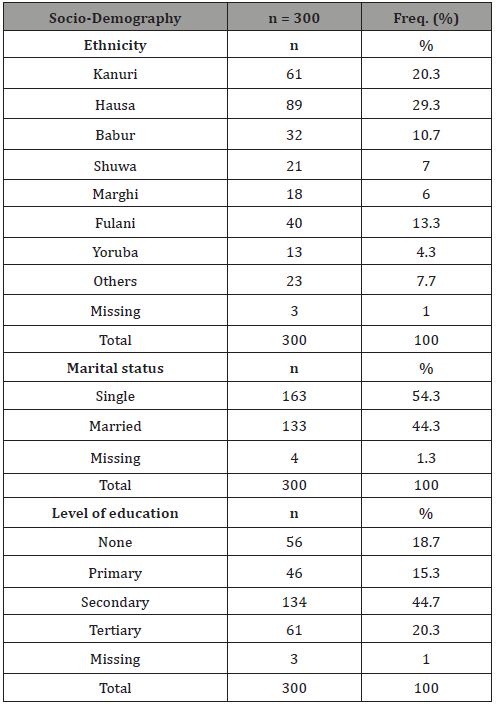
Vehicular and driver behavioural characteristics
For each of the vehicular characteristics assessed in this study, around a fifth of the respondents reported having problem with them, as presented in Table 2, with 17.7% of them reporting having faulty brakes. Table 3 shows the distribution of driver behavioral factors. Over seventy per cent of them engaged in dangerous driving practices, though at different frequency levels. Thirty eight per cent reported taking kola nuts while 24% reported taking some psychoactive substances like cannabis (Table 2 & 3).
Table 2: Vehicular characteristics.
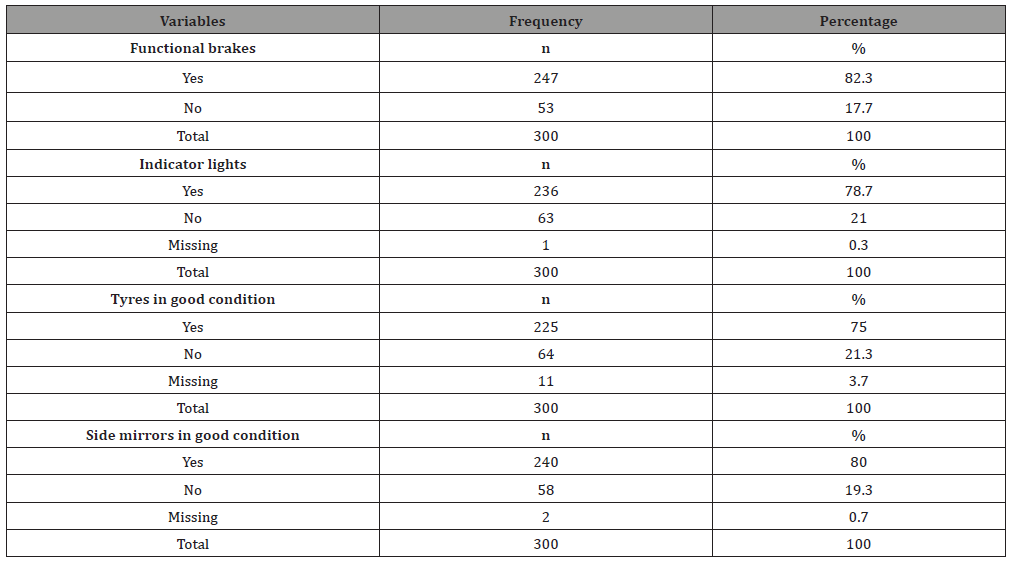
Table 3: Driver behavioral characteristics.
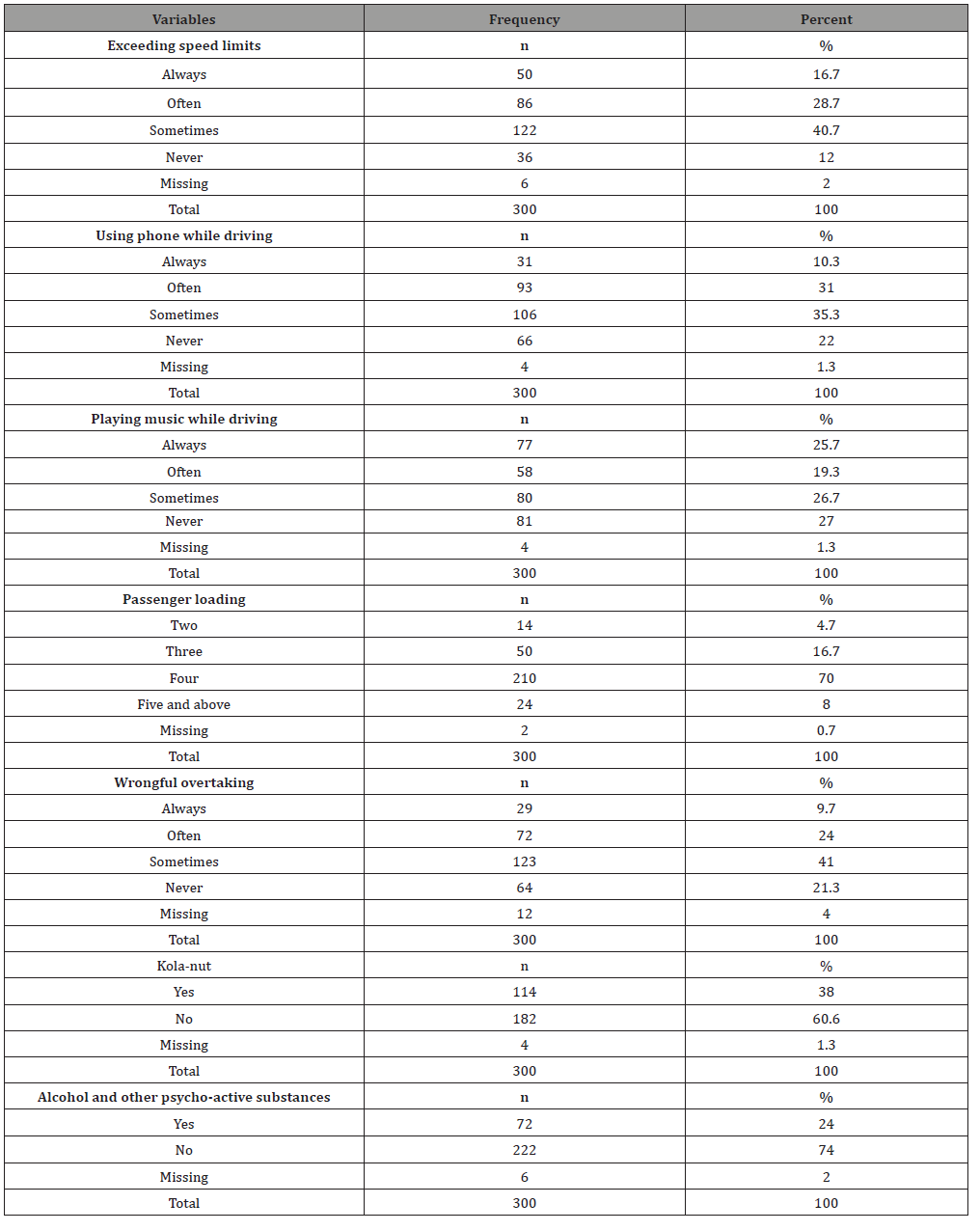
Road traffic crashes and near-misses
One hundred and thirty-eight (46%) and 151 (50.3%) respectively of the respondents, had been involved in at least one road traffic crash or near-miss accident during the previous one year while driving their tricycles as shown in Figure 3. As presented in Table 4, a large number of the near misses had occurred while they were using their phones (45.7%) and under dusty or rainy weather (63.6%). A sizeable proportion also occurred on rough and pot-holed roads (40.4%), narrow (43.0%) and congested roads (50.3%) (Figure 3 & Table 4).
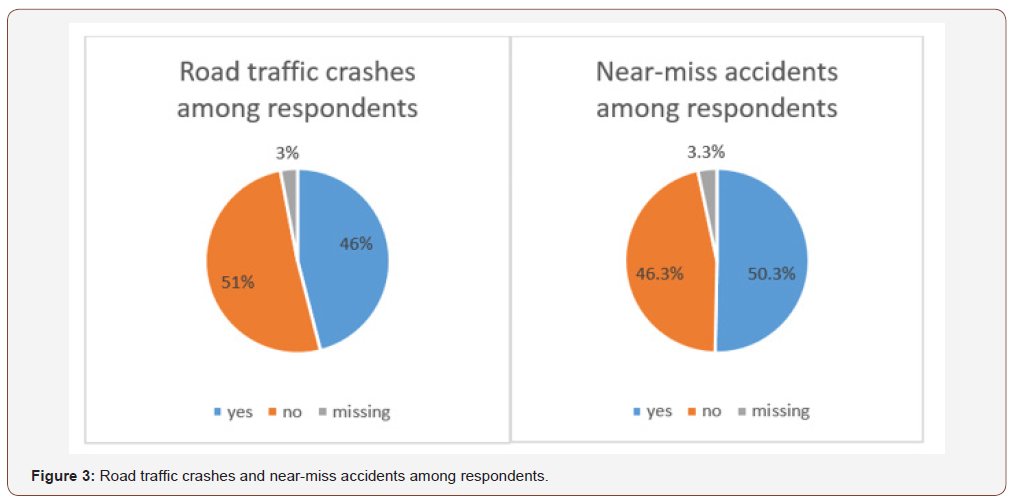
Table 4: Road traffic crashes and near-misses

Factors associated with the occurrence of an accident
Association between driver characteristics and vehicular factors, with accident occurrence are presented in Tables 5 and 6. The responses for driver behavioural factors were collapsed into two levels (‘always’, ‘often’, and ‘sometimes’ collapsed into one category, ‘yes’; and ‘never’ classified as another category, ‘no’) before running the chi-squared test. Only psycho-active substance use (χ2=3.941; df=1; p=0.047) and having experienced more than one near miss (χ2=31.807; df=1; p<0.001) were significantly associated with having an accidents (Tables 5 and 6).
Table 5: Association between driver characteristics and the occurrence of accident.
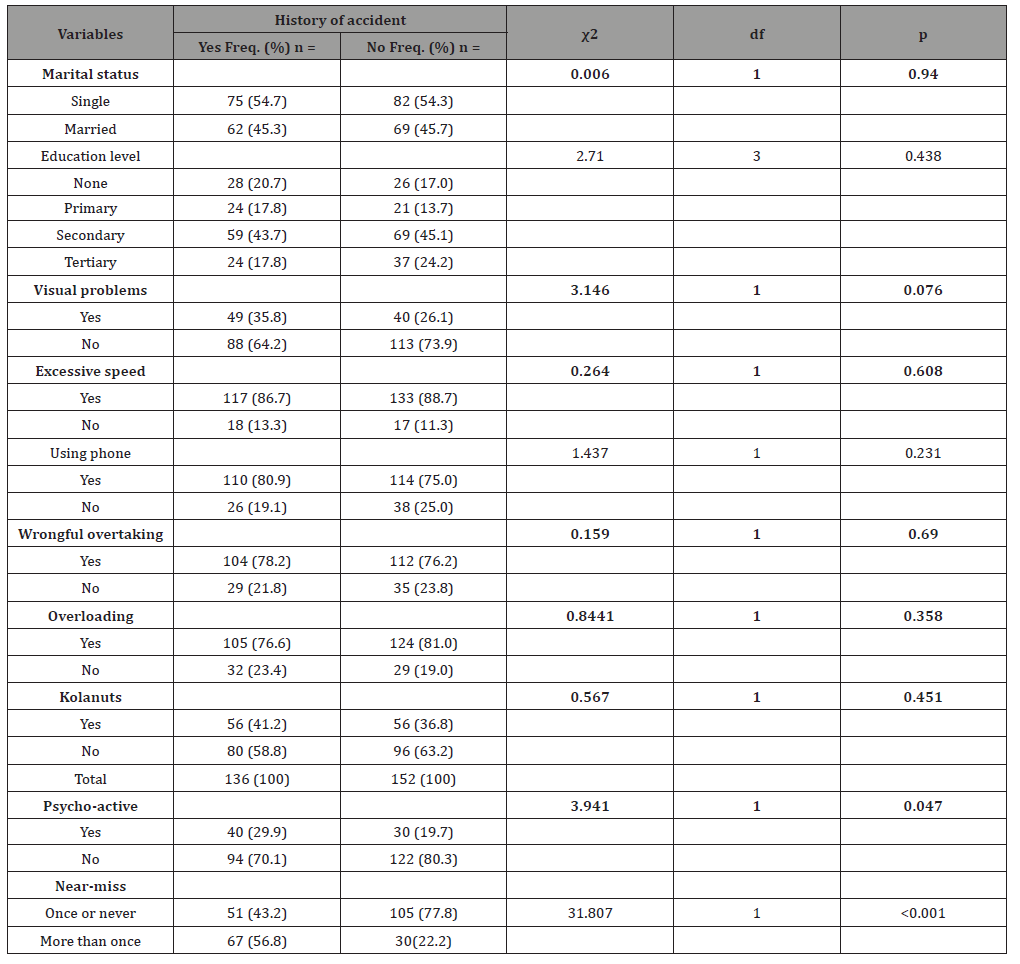
Table 6:Association between vehicular factors and the occurrence of accident.
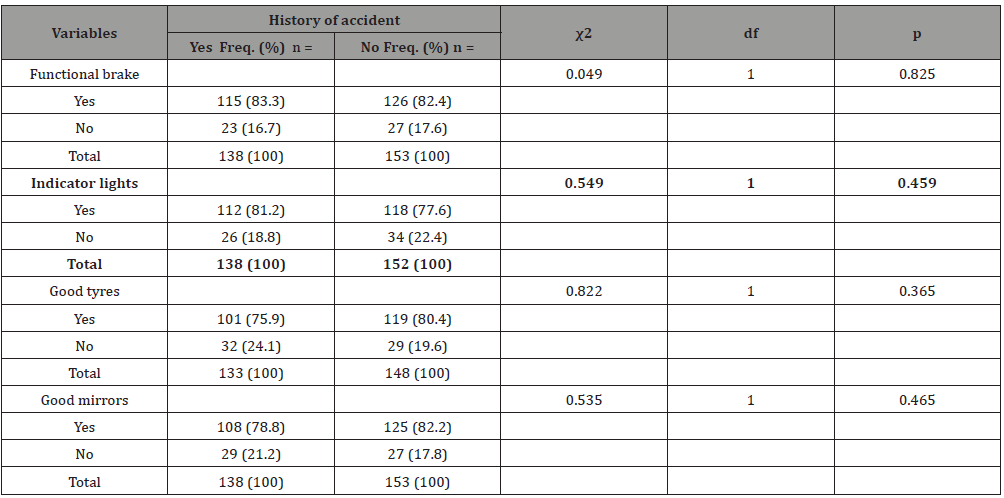
For the multivariate logistic regression, the model fitted the sample, evidenced by a Hosmer-Lomeshow significance value of 0.778. The Negelkerke’s R square also showed that the model explained about 9.8% of the accident occurrence. Having experienced more than one near miss was associated with thrice the odds of having an accident (OR=2.89 95% CI: 1.64-5.09; p<0.001) (Table 7).
Table 7: Predictors of having an accident.
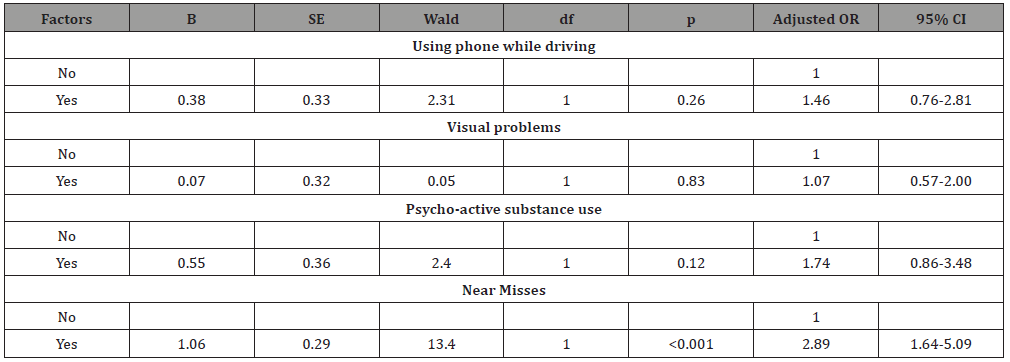
Discussion
It was hypothesized that a complex of socio-demographic factors, driver factors, vehicular factors and road environmental factors predispose to accidents and near-misses. Engagement in risky practices like using the phone while driving; exceeding speed limits; playing music while driving; wrongful overtaking and overloading of passengers were quite high among the respondents. Young age has reportedly been associated with such practices [28,29], and could be the likely reason for the high prevalence of these risky behaviours among the respondents, as only 47% of them were above thirty years of age. Though these practices didn’t show significant association with near-misses or accidents in this study, other studies have demonstrated their significant role in the occurrence of accidents [30,26]. The significant association between psycho-active substance use and accidents were in keeping with previous findings among commercial drivers in a motor park in Port-Harcourt, Nigeria, though not significant in multivariate analysis [31]. Near miss was a predictor of having an actual accident, similar to findings in a previous study [19].
As for the conditions under which the near-misses occurred, only six of those who had experienced a near-miss (3.97%) mentioned that they occurred while they were fully awake; during clear weather; and on a smooth, broad, and non-congested road. All the others had occurred under an unfavourable condition of at least one of these variables. These agree with previous findings of a positive association between sleepiness with both near-miss and actual accidents, [19] and other reports of poor road environmental states as factors in the causation of road traffic accidents [32,30,17]. That the model only explains around 10% of the outcome variable (accidents), further buttresses the complex nature behind accident occurrence, and the possibility of many other predictor factors yet to be explored.
Some limitations of the study include its reliance on selfreporting, for data on vision problem, instead of visual acuity test. Also, this study utilized a cross-sectional study design, making it difficult to ascertain the temporal relationship between the variables. For example, it cannot be categorically concluded that the psycho-active substance use by a respondent pre-dated the accident he experienced.
Conclusion
This study reveals the existence of a high burden of road accidents and near-misses among commercial tricycle drivers in Maiduguri, Nigeria. It is as such recommended for the FRSC and relevant organizations like the NACTOMORAS, to raise awareness among tricycle users and the general public of the high burden of this problem. This can be done by organizing workshops and trainings for tricycle drivers as well as awareness campaigns through the media. This measure is likely to stimulate a conscious effort by the tricycle drivers to adopt safety measures. Vehicles and drivers should also be screened to ensure they meet the minimum standards, before being registered to start the business. Further research should also be conducted to develop, implement and assess the effectiveness of certain interventions in reducing the burden of this problem.
Acknowledgement
None.
Conflict of interest
No conflict of interest.
References
- Nantulya VM, Reich M (2002) The neglected epidemic Road traffic injuries in developing countries. British Medical Journal 324: 1139- 1141.
- Atubi AO (2012) Determinants of road traffic accidents occurrences in Lagos State: Some lessons for Nigeria. International Journal of Humanities and Social Science 2 (6).
- World Health Organization (2013) Global status report on road safety 2013: Supporting a decade of action. Geneva: World Health Organization.
- Sheykh A, Robabeh MA, Mohammad K, et al. (2004) Non communicable disease risk factors in Iran. Asia Pac J Clin Nutr 13: 100.
- Hazen A, Ehiri JE (2006) Road traffic injuries: hidden epidemic in less developed countries. J Natl Med Assoc 98: 73-82
- Nantulya VM, Rerch M (2003) Equity dimensions of road traffic injuries in low and middle – income countries. Injury control and safety promotion 10(1-2): 13-20.
- Juillard C, Labinjo M, Kobusingye O, Hyder AA (2010) Socio-economic impact of road traffic injuries in West Africa: exploratory data from Nigeria. Inj Prev 16: 389-392.
- Hijar M, Carrillo C, Flores M, Anaya R, Lopez V (2000) Risk factors in highway traffic accident cases: A study from South India. Indian Journal of Community Medicine 29: 20-24.
- Muhlrad N, Lassare S (2005) Systems approach to injury control. New Delhi: Macmillan India Ltd.
- Krug EG, Sharona GK, Lozano R (2000) The global burden of injuries. American Journal of Public Health 90: 523-526.
- Bun E (2012) Road Traffic Accidents in Nigeria: A Public Health Problem. AFRIMEDIC Journal 34-36.
- Bekibele CO, Fawole OI, Bamgboye AE, Adekunle LV, Ajav, R, et al. (2007) Risk factors for road traffic accidents among drivers of public institutions in Ibadan, Nigeria. Afr J Health Sci 2007; 14:137-142.
- Akloweg Y, Hayshi Y, Kato H (2011) The effect of used cars on African road traffic accidents: A case study of Addis Ababa, Ethiopia. International Journal of Urban Sciences 15(1): 61-69.
- Gopalakrishnan S (2012) A public health perspective of road traffic accidents. J Fam Med Primary Care 1: 144-150.
- Filani MO, Gbadamosi KT (2007) Identification of cycles and periodic oscillation of road traffic accidents over Lagos State, Nigeria 2(24).
- Arthur N (2015) A survey of commercial drivers’ perception on the causes of road traffic accidents in Nigeria. J Med Trop 17: 12-15.
- Al-Ghaweel I, Saleh A Mursi, Joel P. Jack, Irene Joel (2009) Factors affecting road traffic accidents in Benghazi, Libya. J Fam Community Med 16(1).
- Arai Y, Nishimoto T, Ezaka Y, Yoshimoto K (2001) Accidents and Near-misses Analysis by Using Video Drive-Recorders in a Fleet Test. Proceedings of the 17th ESV conference, Amsterdam 01-S4-0-225.
- Powell NB, Schechtman KB, Riley RW, Guilleminault C, Chiang RP, et al. (2007) Sleepy driver near-misses may predict accident risks. SLEEP 30(3): 331-342.
- Hayward, John C (1972) Near miss determination through use of a scale of danger: 24-34.
- Phimister JR, Oktem U, Kleindorfer PR, Kunreuther H (2003) Near-Miss Inident Management in the Chemical Process Industry. Risk Analaysis 23(3): 445-495.
- DfT (2014) Reported Road Casualties 2013. DfT, London, Great Britain.
- Onyemaechi N, Ofoma UR (2016) The public health threat of road traffic accidents in Nigeria: A call to action. Ann Med Health Sci Res 6: 199-204.
- Waziri M (2009) The Geography of Borno State: An Overview. Issues in the Geography of Borno State 1: 6-12.
- National Bureau of Statistics (2010). The National Literacy Survey.
- Johnson OE (2012) Prevalence and pattern of road traffic accidents among commercial motorcyclists in a city in Southern Nigeria. Educational Research 3(6): 537-542.
- Saw SM, Ng TP (2001) The Design and Assessment of Questionnaires in Clinical Research. Singapore Med J 42(3): 131-135.
- Adoga AA, Oziolo KN (2014) The Epidemiology and Type of Injuries Seen at the Accident and Emergency Unit of a Nigerian Referral Centre. J Emerg Trauma Shock 7(2): 77-82.
- Palamara P, Molnar L, Eby D, Kopinanthan C, Langford J, et al. (2012) Review of young driver risk taking and its association with other risk taking behaviours. Transportation research institute 1: 1-179.
- Singh A, Bhardwaj A, Pathak R, Ahluwalia SK (2011) An Epidemiological Study of Road Traffic Accident Cases at a Tertiary Care Hospital in Rural Haryana. Indian J Comm Health 23(2): 53-55.
- Pepple G, Adio A (2014) Visual function of drivers and its relationship to road traffic accidents in Urban Africa. Springer Plus 3: 47.
- Adejugbagbe AM, Fatiregun AA, Rukewe A, Alonge T (2015) Epidemiology of road traffic crashes among long distance drivers in Ibadan, Nigeria. African Health Sciences 15(2): 480-489.
-
Ahmed Dahiru Balami, Garba Sambo. Road Traffic Accidents, Near-Misses and their Associated Factors among Commercial Tricycle Drivers in a Nigerian City. Annal Biostat & Biomed Appli. 2(3): 2019. ABBA.MS.ID.000539.
Road Traffic Accidents, Tricycle Drivers, Near-miss; Tricycle; Vehicular factors; Driver factors
-

This work is licensed under a Creative Commons Attribution-NonCommercial 4.0 International License.






